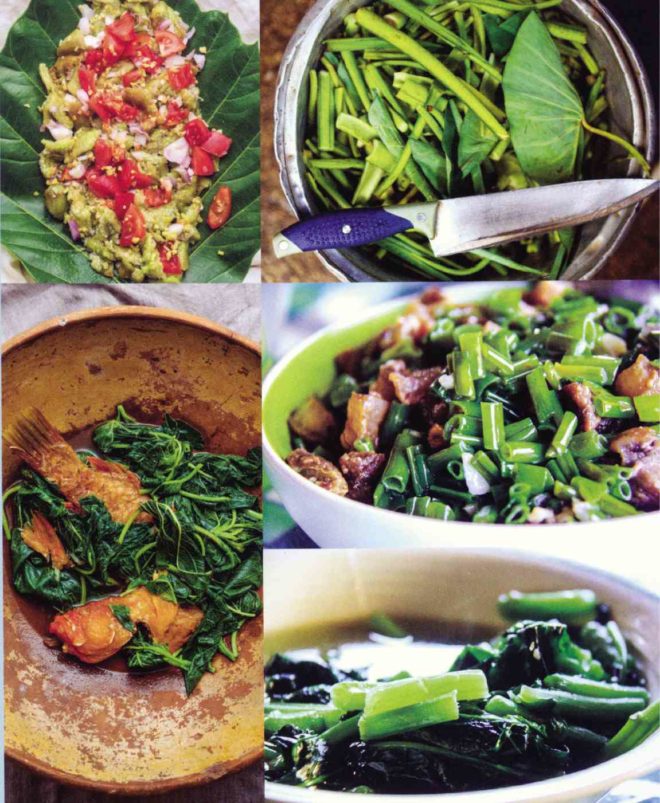
“This is not a food book,” art curator Marian Pastor Roces declares à la Magritte by way of introducing “A Delicate Balance: Batanes Food, Ecology, and Community,” which she wrote with former National Museum director Corazon Alvina.
This is the first of five volumes in the Philippine Food Ecosystems Series, a project of Museo ng Kaalamáng Katutubò (MusKKat).
(Headed by Alvina, MusKKat was established in 2013 to “deploy curatorial and research expertise to sustain ancestral indigenous knowledge systems as well as to make evident the extraordinary value of Philippine ancestral cultures.”)
Of course, it is a food book, just not the kind we’re used to. Instead, it explores, in project benefactor Benjamin W. Yap’s words, “the unique synthesis of Ivatan food and way of life—why the Ivatan choose the food they eat; why the food is prepared in a certain way or stored in a particular manner, and why they farm and fish the way they do.”
It is a parallel investigation of Batanes’ cuisine and culinary applications in relation to its climate, ecology, natural resources, Ivatan sociopolitical system, language and history, since the first Austronesians from Taiwan came to settle on the islands 4,000 years ago.
“Why food? Because food is basic to survival,” says Roces. “And we wanted to examine the idea of the Ivatan’s instinct for survival. Basically, ecosystem ang gusto naming palitawin, not only the natural ecosystem. And food is something that everybody can understand.
“The Philippines was not a rice-eating country. We were a tuber-eating people. And root crops have a complicated system. For example, there are 27 varieties of yam and 21 varieties of camote that we know of, presuming some had gone extinct.”
Here are images, not only of the gold-flecked dolphinfish (arayú or dorado), but also of the storm and the sea; the yam (uvi) side by side with the stone citadel (ijáng); the land snail (maridá) with the landscape and seascape; the sugarcane brew (palék) with the palm-frond protective wear (vakúl).
Beyond technical writing
The 376-page coffee-table book is divided into 10 chapters and lavishly illustrated with images by eminent photographer Neal Oshima.
“We’ve had an old partnership with him,” says Roces. “We’ve been doing this since 1974. We’ve had no difficulties doing the book. Going to Batanes was fun.
“I have 40 years in curatorship and Cora [Alvina] is practically the mother of all coffee-table books. There were three women at the start [of coffee-table-book publishing]—Cora, Gilda [Cordero-Fernando] and Felice [Sta. Maria].” Oshima’s sumptuous photography is complemented by a text that goes beyond serviceable writing or functional prose.
Take this passage on lunyis (pork confit): “It is a severe dish, rescinding all spices, offered and consumed as pure oily animal muscle. Sinewy but wonderfully gnawable, it is cooked with no tenderizing imperative; rather, with a partiality to the delights of chewing into the grain of meat. And into squishy, heavenly fat that liquefies between tongue and palate.”
This is writing that approaches Imagist poetry, though one may argue it’s way too extravagant for its humble subject.
What’s important is, it can be understood by its intended readers, and it disperses deeply researched information providing cultural, historical as well as geologic context for each dish.
“Can I just clarify one thing about research?” says Roces. “It was done by different people—sociologists, folklorists, archeologists. The important thing is, we put their works together, brought them up-to-date, and saw how they fit.
“Cora and I decided to write as writers, not as scientists. We’re just mediums for their works. We just channel their research in words that are compelling to readers. Sinadya namin ni Cora na kaaya-aya naman.”
Something to excite
Another feature remarkable for a food book is the inclusion not only of recipes but also basic information on the nutritional values of a particular dish’s ingredients.
“We do not do books as tourists—passing through and getting excited about a place or cuisine,” says Roces. “We’re not excited about consuming experiences. That’s what tourists do. Wala naman kaming angal d’yan, but it’s just not our thing.”
She says their food book was not intended to be exciting like it would excite gourmets but “exciting for how profoundly important something is.”
While flipping over the pages, a reader might get excited or experience a shock of recognition as many of these Ivatan dishes appear to be common to all Filipino tables, with only some modifications in ingredients and preparation.
In fact, a few look like haute cuisine in Makati restos. The indigenous root crisps look like one can find in fast-food joints and grocery stores all over the country.
Even the Ivatan food storage and eating habits are applicable to many Filipino communities. Such as atatay or “the sharing of food and objects.” Or chimuchimusén, “nibbles from casual foraging” (the Ilonggo term is timo-timo or “eating in small portions,” like a bird).
Quite interesting is the last chapter dealing with the Ivatan concept of the vanuá (port), a modified application of which can be found in as far as Palawan, Panay, Negros and Mindanao. Consider the Visayan term banwa (for bayan, or “town”).
This is a fitting finale, as it encapsulates the sentiment and idea that, despite the diversity of Philippine cultures, we truly are one people.